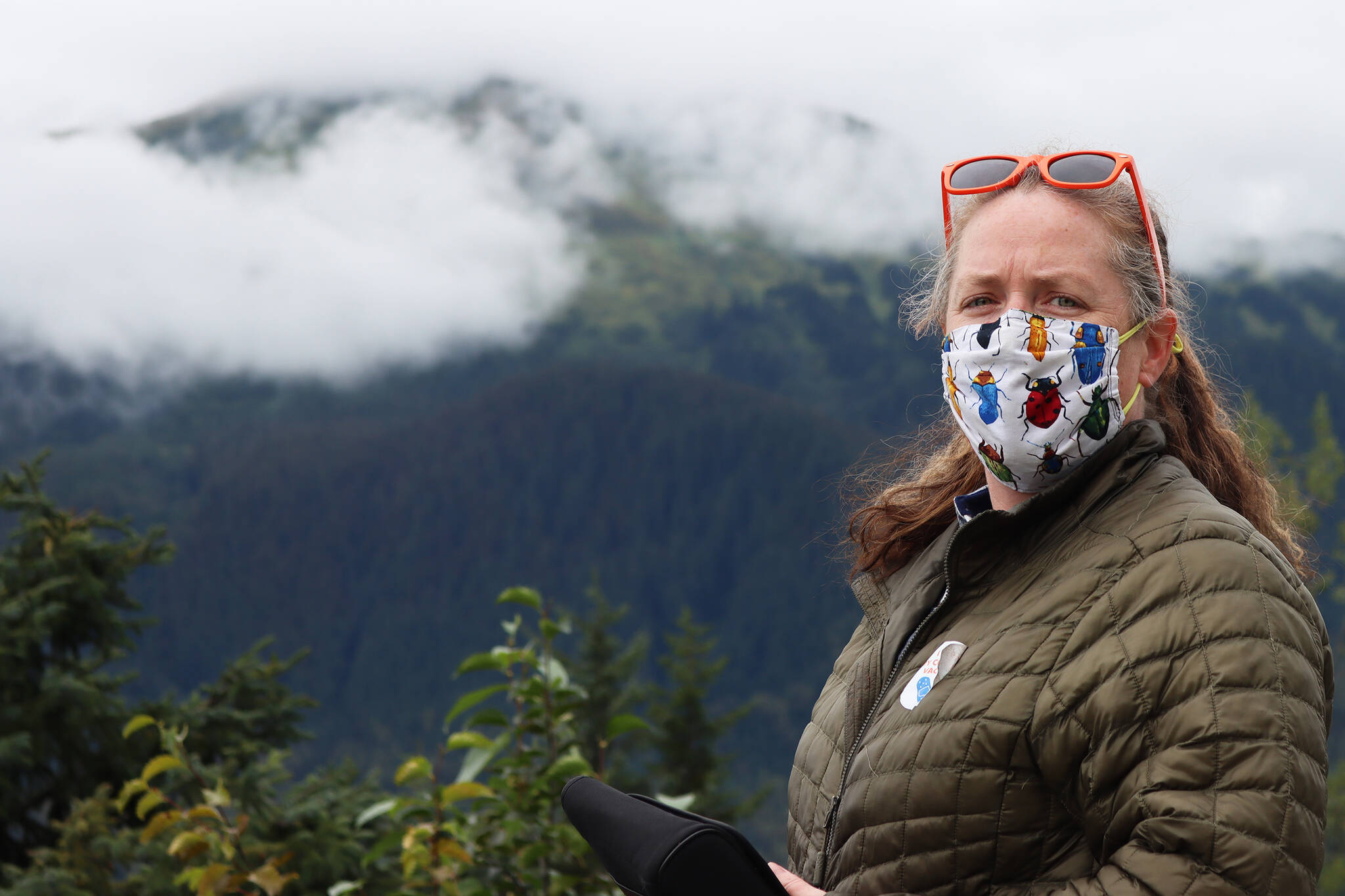A bump of atypically brown-tinged hemlock trees is evident on Mount McGinnis —at least on the recently rare days that it’s visible from the Mendenhall Glacier Visitor Center. When viewed through a pair of binoculars, or a strong enough zoom lens, it’s evident the trees are missing needles.
Similar discolored and patchy trees can be seen at other popular, local recreation areas, including the John Muir Trail, as well as locations further afield in Southeast Alaska, according to Elizabeth Graham, entomologist for the U.S. Forest Service.
In both cases, Graham said, the off-looking trees are the work of the same voracious insect —black-headed budworms.
“This is a natural part of our forest,” Graham said. “So, the budworm’s been around as long as the trees have.”
The black-headed budworm is an insect native to the Western U.S., according to USFS. The caterpillar is what’s known as a “wasteful feeder” as it does not typically eat entire needles, according to USFS. The partially eaten, dead needles are what give trees, like the hemlocks on McGinnis, a brown or red appearance.
While black-headed budworms are always a part of Southeast Alaska’s forests, outbreaks like the one ramping up aren’t especially common.
“It happens every 30-4o years or so here in Southeast,” Graham said. “And it gets to the point where we have these whole hillsides that are defoliated.”
Conditions that can lead to an uptick in budworm population include warmer summers, like the ones Southeast Alaska saw in 2018 and 2019, Graham said.
“It’s possible these populations were building then, but we weren’t seeing them because they start up in the crown,” Graham said.
The budworm-caused defoliation is likely to become more pronounced in the future, too.
“This is still pretty light right now compared to some of the areas that have been hit really hard,” Graham said. “Based on the number of moths that we’ve been seeing flying around town right now, this is likely just the beginning of the outbreak, so we’ll see more activity here in Juneau next year.”
The moths are an indicator because budworms pupate and emerge as mottled moths that Graham said will likely be common to see fluttering around Juneau until October.
“They’re little brown or beige kind of rectangular-looking moths,” Graham said. “They’re active during the day.”
Those moths, which live for several weeks, lay their eggs on hemlock needles. Eggs are laid on a one-per-bud basis to avoid pitting larvae against one another for food, Graham said. Then, in the summer, around the same time that the buds burst, the caterpillars burst and begin mining the buds before moving on to new growth. While hemlocks are a preferred host, Graham said, other coniferous trees, including Sitka spruce, may also provide food and shelter to black-headed budworms.
[Wild Shots: Photos of Mother Nature in Alaska]
The wasteful feeding can lead to a “startling” red color on trees that people may mistake for a bark beetle attack, Graham said. While growth may slow and the top third or so of a tree may die because of budworms, trees are generally able to withstand the defoliation because they have older needles that the budworms tend to avoid.
While people may not like the appearance of budworm-nibbled trees, Graham said they serve an important ecological role.
“They open up the canopy when there’s this kind of outbreak,” she said. “It causes such an extreme amount of defoliation when they’re in this heavy amount that you’re going to get more light that comes down to the forest floor. They also increase the amount of nutrients going to the forest floor, so they act as nutrient recyclers.”
That nutrient recycling is done through eating and excreting.
“A lot of people reported it sounding like raining in the summertime even though it wasn’t raining, and that was the frass, falling from the canopy and onto the devil’s club and the plants below,” Graham said.
Trees’ company
The black-headed budworm isn’t the only insect that’s recently been noshing on Juneau’s hemlock trees.
There were outbreaks of hemlock sawflies, another defoliator native to the area, in 2018 and 2019, Graham said.
“They feed on the older needles, so we have trees, like ones on the John Muir Trail, that were heavily hit by sawfly, that don’t have many old needles,” Graham said.
The combined effect of the two outbreaks could kill trees, Graham said.
“We’ve had outbreaks like this in Southeast Alaska in the past,” Graham said. “There was one in the 1950s where there was sawfly and budworm as well, and in some areas, there was mortality experienced, and that’s just part of the changing forest. It creates new gaps, and it’s one of our big disturbance agents that we have here.”
That leads to more understory and opens up spots for new trees to grow.
“It is important to distinguish this from a non-native insect,” Graham said. “This isn’t something we would want to eradicate or control because in some ways it’s doing its job.”
Nothing lasts forever
Black-headed budworm outbreaks end without human intervention.
“It’s not going to sustain,” Graham said. “Eventually, it’s going to crash.”
She said outbreaks typically last for two to three years.
The caterpillars eventually run out of food to eat. Other limiting factors include a fungal disease, a virus, parasites and parasitic wasps.
“And then, we won’t see a big outbreak again for hopefully a few more decades,” Graham said.
Additionally, the ongoing outbreak seems far less disruptive to human life than the one observed in the ’50s.
“It’s not as extreme as the outbreak in the ’50s,” Graham said. “There were reports of 65 moths per square foot on the Juneau Icefield. They were getting blown up there. And there were planes flying out of Petersburg that reported moths hitting their windshield and having visibility issues because of that many moths flying. It can be a major event.” ‘
• Contact Ben Hohenstatt at (907)308-4895 or bhohenstatt@juneauempire.com. Follow him on Twitter at @BenHohenstatt

